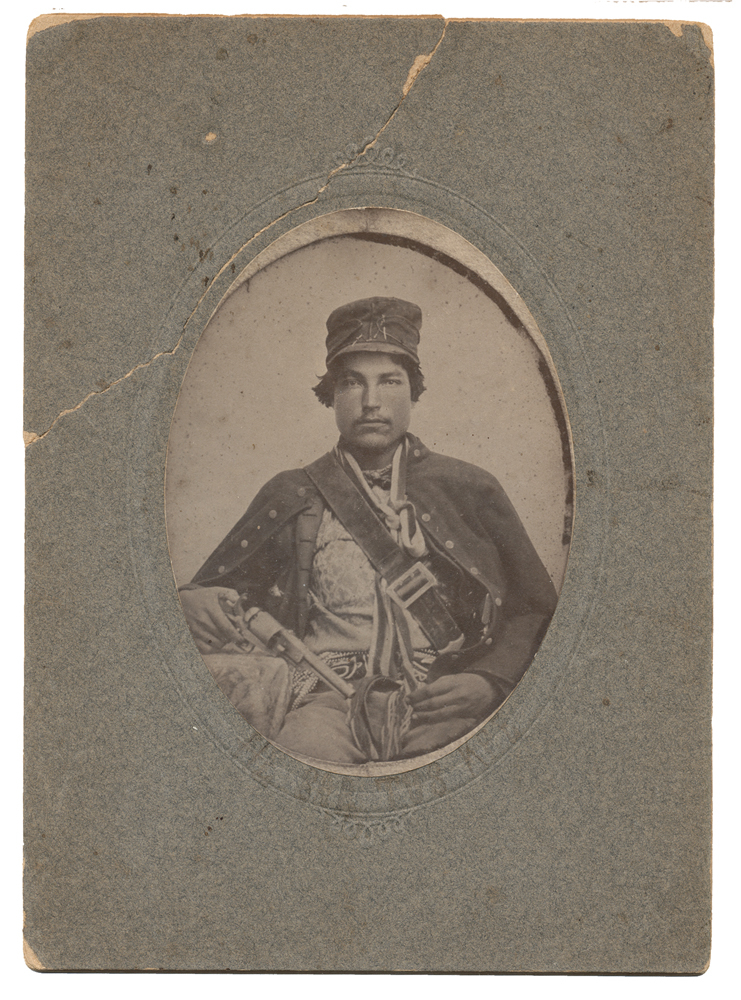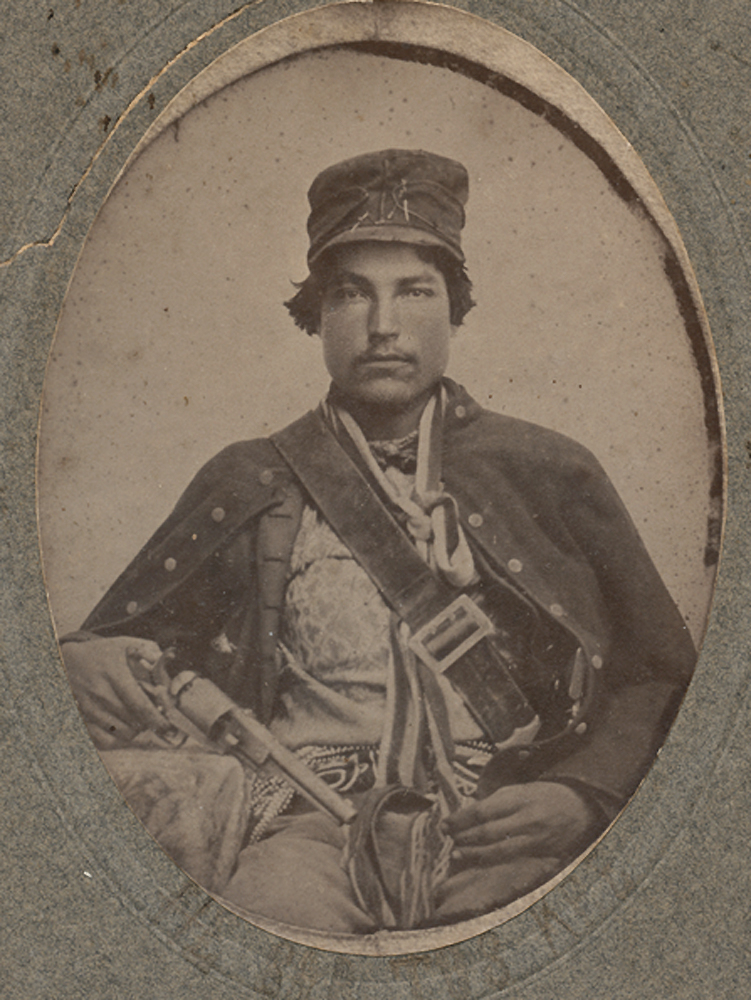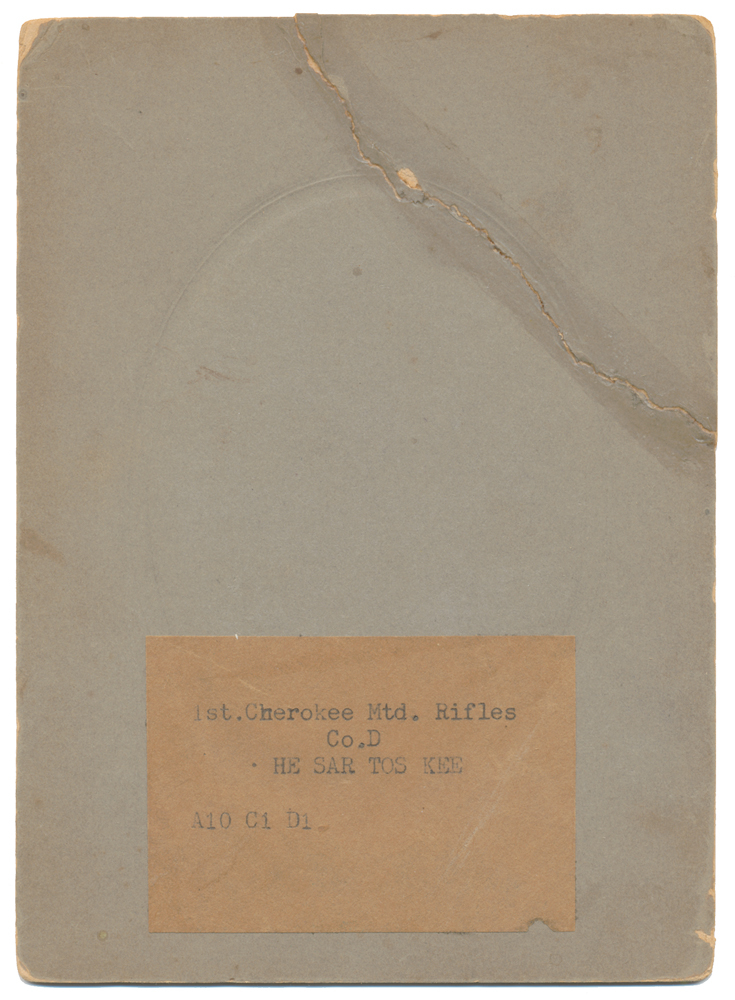site search
online catalog
RARE CABINET CARD OF C.S. CHEROKEE SOLDIER, 1ST CHEROKEE MOUNTED RIFLES

Hover to zoom



$1,500.00 SOLD
Quantity Available: None
Item Code: 1139-500
Oval, second generation image of seated Cherokee soldier. Photo retains very strong detail despite being a second generation (mat on original photo is visible and buttons and sling buckle appear to have been gilted in original which blocks detail in copied photo). Soldier wears a military coat with many buttons. He also has a rather unique hat on his head and a beaded "Indian" waist belt. There is a carbine sling over his shoulder and he holds a cocked revolver in his hand. The butt of a second revolver is just visible inside his coat on right side. Photo is on a pasteboard mount with a pressed oval "picture frame" design. Top, left corner of pasteboard has been repaired. No photographer's credits front or back. An old typed label is attached to the back: "1st Cherokee Mtd. Rifles / Co. D / HE SAR TOS KEE".
Company D was mustered in 25 Oct 1861, at Fort Gibson, Indian Nations. He Sar Tos Kee was 23 years old from the Delaware District.
Confederate officials commissioned Stand Watie a colonel in the Confederate States Army in July 1861 and authorized him to raise a military unit known as the Cherokee Mounted Volunteers. After Cherokee Principal Chief John Ross signed the Cherokee-Confederate treaty of alliance in October 1861, he and the Cherokee Council raised the 1st Regiment of Cherokee Mounted Rifles, commanded by Col. John Drew. At this time, Watie's regiment became the 2nd Regiment of Cherokee Mounted Rifles. Watie's regiment consisted largely of Cherokees of mixed blood (Métis) who, as slaveholders, favored the Confederate cause.
A portion of Drew's regiment deserted in late 1861. Following the Battle of Old Fort Wayne in October 1862, most of the remainder of Drew's men deserted to the Union army. What remained was combined with Watie's regiment and reorganized as the 1st Regiment of Cherokee Mounted Rifles with Watie in command.
Watie's troops participated in 27 major engagements and numerous smaller skirmishes. Most of their activities utilized guerrilla tactics. Watie's men launched raids from south of the Canadian River throughout northern-held Indian Territory and into Kansas and Missouri, tying down thousands of Union troops. Poorly equipped and armed mostly with castoff rifles or captured weapons, the Cherokees were well suited to this type of warfare. Watie was promoted to brigadier general in May 1864.
Watie's most spectacular victories included the Ambush of the steamboat J. R. Williams, in June 1864, and the capture of a Union wagon train at the Second Battle of Cabin Creek in September 1864. His three most infamous actions were the burning of Rose Cottage, home of Chief John Ross, and the Cherokee Council House in October 1863, and the massacre of detachments of the First Kansas Colored Infantry and 2nd Regiment Kansas Volunteer Cavalry at the Hay Camp Action in September 1864.
In February 1865 Watie was given command of the Indian Division of Indian Territory but was unable to launch any offensive operations. He released most of his troops following the collapse of Confederate resistance in the spring of 1865. Stand Watie officially surrendered on June 23, 1865, becoming the last Confederate general to lay down his arms. The regiment was dissolved. [jet] [ph:L]
~~~~~~~~~~~~~~~~~~~~~~~~~~~~~~~~~~~
THIS ITEM, AS WITH ALL OTHER ITEMS AVAILABLE ON OUR WEB SITE,
MAY BE PURCHASED THROUGH OUR LAYAWAY PROGRAM.
CLICK HERE FOR OUR POLICIES AND TERMS.
THANK YOU!
Inquire About RARE CABINET CARD OF C.S. CHEROKEE SOLDIER, 1ST CHEROKEE MOUNTED RIFLES
Most Popular
Historical Firearms Stolen From The National Civil War Museum In Harrisburg, Pa »
Theft From Gravesite Of Gen. John Reynolds »
Selection Of Unframed Prints By Don Troiani »
Fine Condition Brass Infantry Bugle Insignia »
Large English Bowie Knife With Sheath 1870’S – 1880’S »
Imported (Clauberg) Us Model 1860 Light Cavalry Officer's Saber »
featured item
WONDERFUL CONDITION ORIGINAL CONFEDERATE-MANUFACTURED KEPI FOR A DRUMMER BOY OR CHILD
This article of uniform clothing is an original, Civil War example of headgear manufactured in the Confederacy and presented here in wonderful, original intact condition. The period artifact is a small, dark blue colored, wool kepi, suited for a… (526-68). Learn More »


